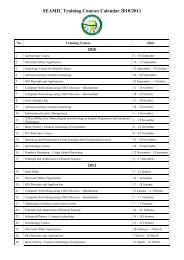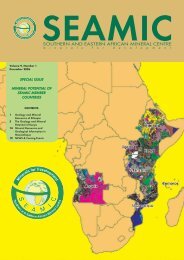SEAMIC Newsletter Vol. 10
SEAMIC Newsletter Vol. 10
SEAMIC Newsletter Vol. 10
You also want an ePaper? Increase the reach of your titles
YUMPU automatically turns print PDFs into web optimized ePapers that Google loves.
♦<br />
♦<br />
♦<br />
Karagwe-Ankolean System-(1,400-1,300 Ma): This system lies unconformably on the<br />
Buganda-Toro System in the south-west. The rocks are similar to the Buganda-Toro<br />
formations but are less metamorphosed.<br />
Madi Series: The Madi series occupy a small area in the north-west and is comprised of<br />
flaggy arenites interbedded with argillites containing ferruginous and calcareous layers,<br />
folded on north-northwesterly trending and gently plunging axes.<br />
Kyoga Series: The Kyoga series occur on the northern side of Lake Kyoga and comprises<br />
shales and quartzitic sandstones of upper proterozoic age (540-1,000 Ma).<br />
Precambrian: Non-granitized formations<br />
♦ The Singo, Mityana and Bukoban Series: These are mainly arenaceous, unmetamorphosed<br />
and little folded.<br />
♦ The Kavirondian: This system lies against and appears to post-date the Nyanzian System.<br />
It is made up of grits, greywackes and quartzites.<br />
♦ The Bunyoro Series: The rocks are made up of shales and phyllites with larger quantities<br />
of grits, arkoses and tillites, gently folded and appear to overlie directly the undifferentiated<br />
gneiss complex.<br />
Other rocks<br />
♦ The granite-gneiss domes ‘Arena granites’: Mobilized basement rocks mantled in<br />
Karagwe-Ankolean rocks are found in southwest Uganda while gneiss domes have been<br />
identified in gneisses of West Nile.<br />
♦ Intrusives: Intrusive rocks occur in many parts of Uganda, the old known intrusives<br />
including the Masaba and Bududa granites date back to 2900 Ma (lead ages).<br />
Paleozoic Rocks<br />
The most northerly known rocks of the Karoo in Africa comprising shale containing<br />
glossopteris flora occur in small down-faulted outliers near Bugiri on Dagusi Island and<br />
underlying part of Entebbe. They were deposited between 250 and 540 Ma.<br />
Mesozoic and Cainozoic Rocks<br />
The eastern volcanic rocks of Cretaceous to Miocene age (135 – 5.30 Ma) comprise generally<br />
soda-rich agglomerates, lavas and tuffs extruded by central volcanoes represented by mountains<br />
Moroto, Kadam and Elgon. Carbonatite ring complexes at Tororo, Sukulu, Bukusu and Napak<br />
and syenite complexes such as Zulia represent eroded remnants of volcanics of similar<br />
geological suite. They are underlain by sediments of the Bugisu Series associated with Mt.<br />
Elgon.<br />
The Western Rift Valley Sediments are divided into several series such as the Kaiso, Kisegi and<br />
Semliki beds. They contain some fossiliferous that ascribe to Pliocene to Pleistocene age (3.4-<br />
1.75 Ma) and measures up to 4000 m depth.<br />
The Western volcanic formations are Pleistocene in age (~1.75 Ma) and unusually potash-rich.<br />
They form the prominent cones of Bufumbira in the southwest belonging to the volcanic suite<br />
still active in the Democratic Republic of Congo. Further north, along the Rift Valley,<br />
Pleistocene volcanic activity is represented by several explosion craters of Katwe-Kikorongo,<br />
Kichwamba and Fort Portal.<br />
Lateritisation: is widespread throughout the country and remnants of Cretaceous laterites cap<br />
many hills.<br />
16




